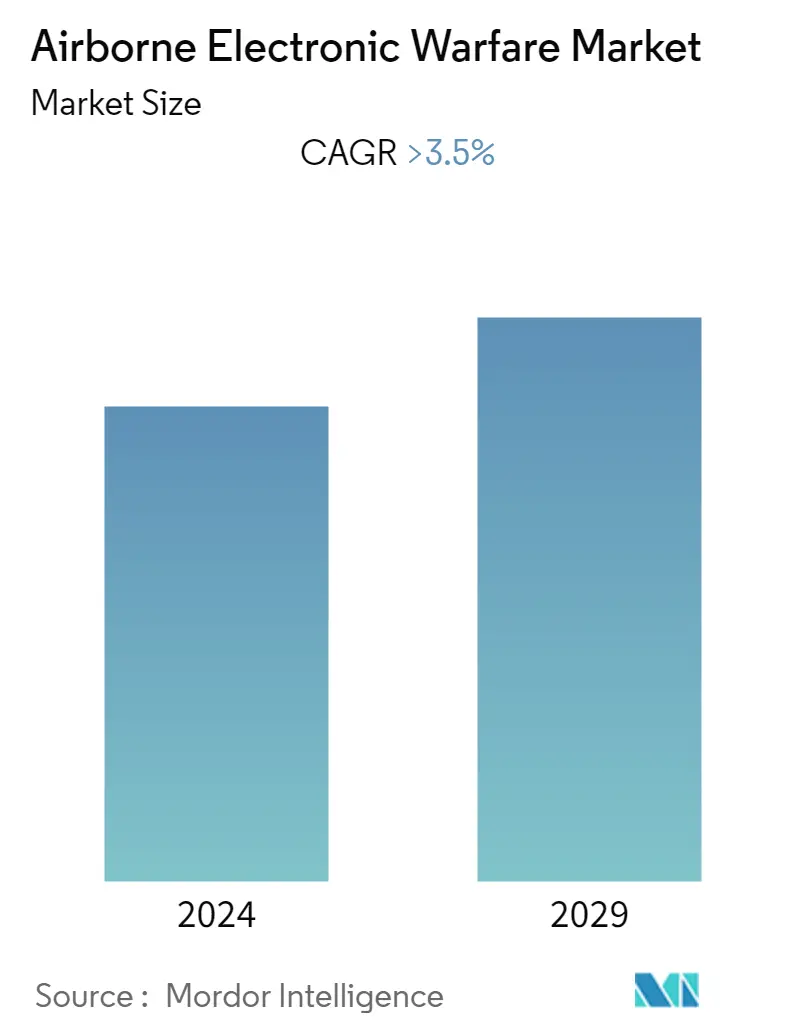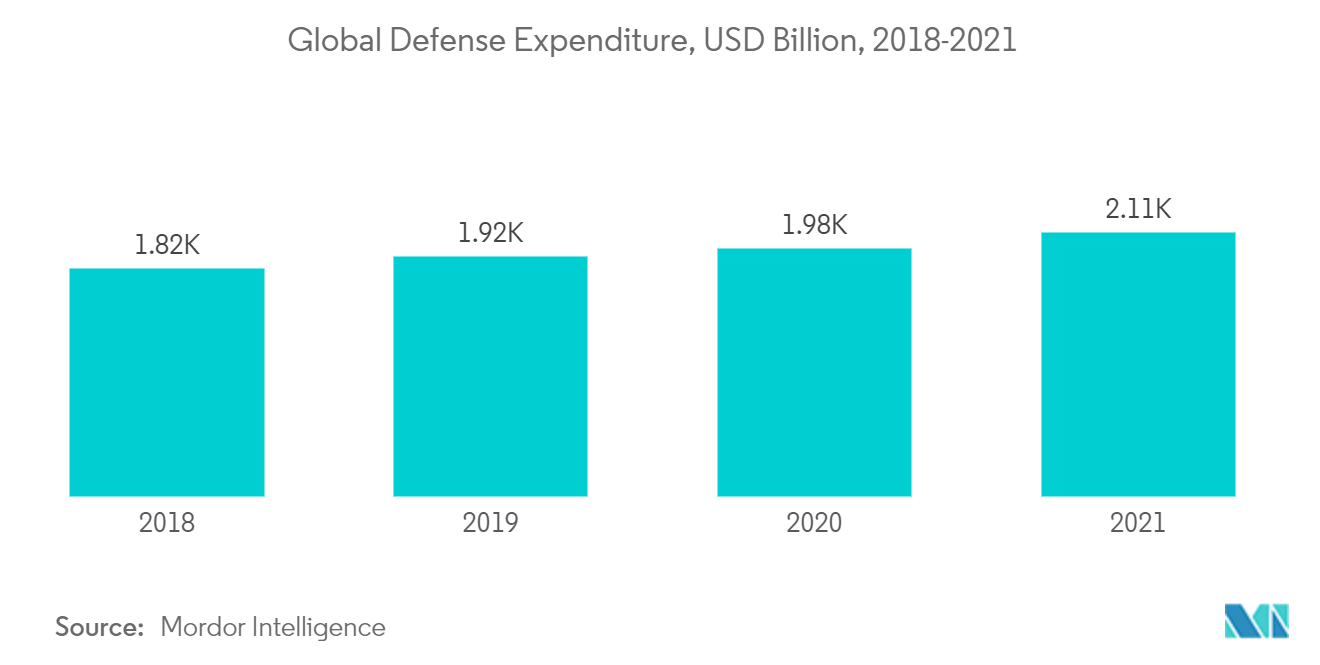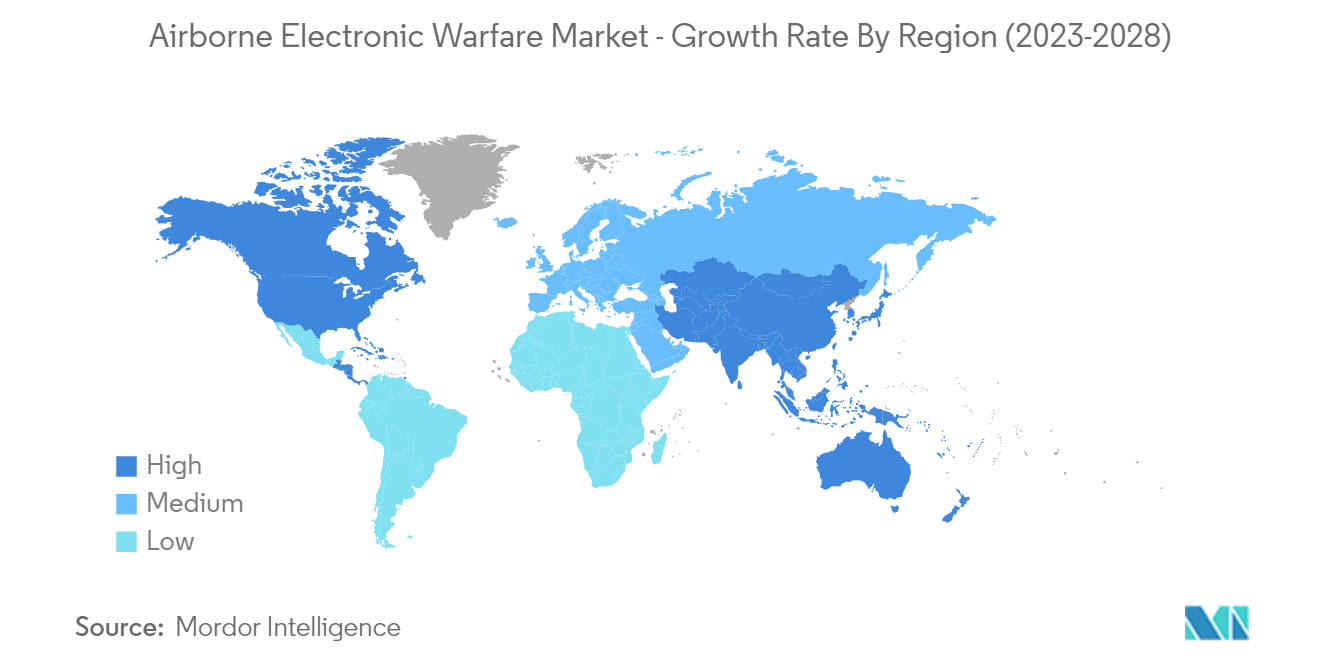Airborne Electronic Warfare Market Size

| Study Period | 2019 - 2029 |
| Base Year For Estimation | 2023 |
| CAGR | > 3.50 % |
| Fastest Growing Market | Asia Pacific |
| Largest Market | North America |
| Market Concentration | Medium |
Major Players.webp)
*Disclaimer: Major Players sorted in no particular order |
Airborne Electronic Warfare Market Analysis
The airborne electronic warfare market is anticipated to register a CAGR of more than 3.5% during the forecast period.
- Despite the impact of the COVID-19 pandemic on the global economy, the military expenditure of several countries remained constant, if not higher, than in previous years. Global military expenditure was USD 1.98 trillion in 2020 and was increased by 0.7% to USD 2.1 trillion in 2021.
- The supply chain disruption caused by the pandemic had a slightly negative impact on the airborne electronic warfare market. This disruption caused mild disruptions to the ongoing activities of product innovation and manufacturing for a brief period in 2020. However, as the market has recovered from the pandemic, the airborne electronic warfare (EW) market has gained a stable position in the market.
- The increasing demand for intelligence, surveillance, and reconnaissance (ISR) systems from various armed forces around the world is anticipated to drive the growth of the airborne electronic warfare market over the coming years.
- Furthermore, the advancements in technology in the areas of enhanced stealth capabilities of aircraft, communication jamming technology, and advanced air defense systems are generating demand for air electronic protection and support measures in combat and non-combat aircraft.
Airborne Electronic Warfare Market Trends
Unmanned Aircraft Segment to Witness Rapid Growth During the Forecast Period
- Unmanned platforms such as unmanned aerial vehicles (UAVs) have emerged as the primary platform for conducting ISR missions. Hence the UAV manufacturers are striving to develop stealth capabilities for their product portfolio by incorporating advanced materials and designs that lower the radar cross-section of a given platform, allowing it to evade radar and integrated air defense systems. Moreover, these platforms are equipped with electronic countermeasures such as jam-resistant data links to prevent enemy disruptions.
- Current missions of such platforms entail the creation of operational orbits that utilize intelligence, surveillance, and reconnaissance (ISR) platforms to collect multiple forms of ISR data, including electronic signals (SIGINT), images (IMINT), and full-motion video (FMV). New models are continuously being launched to serve the defense forces. For instance, in August 2022, China unveiled the FH-35 UAV that can work as part of a more extensive drone formation, providing electronic warfare support to manned and unmanned aircraft.
- More UAVs with electronic warfare capabilities are anticipated to be launched during the forecast period and inducted into active service by the global defense forces at a rapid pace, thereby driving the growth of the unmanned aircraft segment of the market.

North America to Dominate the Market During the Forecast Period
- The presence of major military aircraft manufacturers, such as The Boeing Company, Northrop Grumman Corporation, and Lockheed Martin Corporation in the United States, has had a positive effect on the research and development (R&D) and deployment of airborne electronic warfare systems in the region. The United States is currently the largest market for electronic warfare aircraft, with several ongoing and planned initiatives to develop and induct advanced airborne electronic warfare systems.
- On this note, to maintain electronic warfare capabilities and support the future development of the US Air Force, it is currently upgrading the EC-130H compass call electronic warfare payloads. The US Air Force also has plans to procure 12 EC-37s during the next decade.
- According to the Congressional Budget Office, the US Air Force procurement cost is estimated to increase from USD 28 billion in 2020 by 11% to USD 31 billion in 2024, a part of which is envisioned to be spent on the procurement of various aircraft and unmanned aerial vehicle (UAV) programs with electronic warfare capabilities.

Airborne Electronic Warfare Industry Overview
Lockheed Martin Corporation, Raytheon Technologies Corporation, BAE Systems plc, Saab AB, and Northrop Grumman Corporation are some of the prominent players in the airborne electronic warfare market. In addition to the major manufacturers of electronic warfare systems, several regional manufacturers support various aircraft programs with their EW suites.
The defense forces are adopting both small-scale innovation and development and contractor-owned, contractor-operated (COCO) approaches to mitigate the constraints associated with development contracts while permitting integration, testing, and refinement of early-stage products. Moreover, the development of modular and advanced electronic warfare solutions that can be integrated into several aircraft programs is also being focused on to enhance the threat identification and countermeasure capabilities of current-generation platforms.
Airborne Electronic Warfare Market Leaders
-
Lockheed Martin Corporation
-
Northrop Grumman Corporation
-
Saab AB
-
BAE Systems plc
-
Raytheon Technologies Corporation
*Disclaimer: Major Players sorted in no particular order
.webp)
Airborne Electronic Warfare Market News
- March 2022: BAE Systems plc launched its versatile Storm electronic warfare modules designed to provide customized, state-of-the-art offensive and defense electronic warfare mission systems for combat platforms for the broader United States and allied fleets. Storm electronic warfare modules use a proven common core architecture to accelerate the delivery of software-based electronic warfare capabilities, providing warfighters with the situational awareness, survivability, and electromagnetic capabilities needed for today's complex missions.
- November 2021: Lockheed Martin Corporation was awarded a contract worth USD 585 million to aid the F-35 Aircraft Program by providing system integration engineering for the development of new ASQ-239 electronic warfare/countermeasure hardware to support the F-35 aircraft.
Airborne Electronic Warfare Market Report - Table of Contents
1. INTRODUCTION
1.1 Study Assumptions
1.2 Scope of the Study
2. RESEARCH METHODOLOGY
3. EXECUTIVE SUMMARY
4. MARKET DYNAMICS
4.1 Market Overview
4.2 Market Drivers
4.3 Market Restraints
4.4 Porter's Five Forces Analysis
4.4.1 Bargaining Power of Buyers/Consumers
4.4.2 Bargaining Power of Suppliers
4.4.3 Threat of New Entrants
4.4.4 Threat of Substitute Products
4.4.5 Intensity of Competitive Rivalry
5. MARKET SEGMENTATION
5.1 Capability
5.1.1 Electronic Attack
5.1.2 Electronic Protection
5.1.3 Electronic Support
5.2 Type
5.2.1 Manned Aircraft
5.2.2 Unmanned Aircraft
5.3 Geography
5.3.1 North America
5.3.1.1 United States
5.3.1.2 Canada
5.3.2 Europe
5.3.2.1 United Kingdom
5.3.2.2 Germany
5.3.2.3 France
5.3.2.4 Russia
5.3.2.5 Rest of Europe
5.3.3 Asia-Pacific
5.3.3.1 China
5.3.3.2 Japan
5.3.3.3 India
5.3.3.4 South Korea
5.3.3.5 Rest of Asia-Pacific
5.3.4 Latin America
5.3.4.1 Mexico
5.3.4.2 Brazil
5.3.4.3 Rest of Latin America
5.3.5 Middle East and Africa
5.3.5.1 Saudi Arabia
5.3.5.2 United Arab Emirates
5.3.5.3 Israel
5.3.5.4 Rest of Middle East and Africa
6. COMPETITIVE LANDSCAPE
6.1 Vendor Market Share
6.2 Company Profiles
6.2.1 Lockheed Martin Corporation
6.2.2 Raytheon Technologies Corporation
6.2.3 L3Harris Technologies Inc.
6.2.4 BAE Systems plc
6.2.5 ASELSAN AS
6.2.6 Northrop Grumman Corporation
6.2.7 THALES
6.2.8 Saab AB
6.2.9 Leonardo S.p.A.
6.2.10 Elbit Systems Ltd
6.2.11 Israel Aerospace Industries Ltd.
6.2.12 Terma Group
7. MARKET OPPORTUNITIES AND FUTURE TRENDS
Airborne Electronic Warfare Industry Segmentation
Electronic warfare (EW) is any action involving the use of the electromagnetic spectrum (EM spectrum) or directed energy to control the spectrum, attack an enemy, or impede enemy assaults.
The airborne electronic warfare market has been segmented by capability, type, and geography. By capability, the market is segmented into electronic attack, electronic protection, and electronic support. By type, the market is segmented into manned aircraft and unmanned aircraft. By geography, the market is segmented into North America, Europe, Asia-Pacific, Latin America, and Middle East and Africa.
The report offers market size and forecasts for all the above segments in terms of value in USD billion.
| Capability | |
| Electronic Attack | |
| Electronic Protection | |
| Electronic Support |
| Type | |
| Manned Aircraft | |
| Unmanned Aircraft |
| Geography | |||||||
| |||||||
| |||||||
| |||||||
| |||||||
|
Airborne Electronic Warfare Market Research FAQs
What is the current Airborne Electronic Warfare Market size?
The Airborne Electronic Warfare Market is projected to register a CAGR of greater than 3.5% during the forecast period (2024-2029)
Who are the key players in Airborne Electronic Warfare Market?
Lockheed Martin Corporation, Northrop Grumman Corporation, Saab AB, BAE Systems plc and Raytheon Technologies Corporation are the major companies operating in the Airborne Electronic Warfare Market.
Which is the fastest growing region in Airborne Electronic Warfare Market?
Asia Pacific is estimated to grow at the highest CAGR over the forecast period (2024-2029).
Which region has the biggest share in Airborne Electronic Warfare Market?
In 2024, the North America accounts for the largest market share in Airborne Electronic Warfare Market.
What years does this Airborne Electronic Warfare Market cover?
The report covers the Airborne Electronic Warfare Market historical market size for years: 2019, 2020, 2021, 2022 and 2023. The report also forecasts the Airborne Electronic Warfare Market size for years: 2024, 2025, 2026, 2027, 2028 and 2029.
Airborne Electronic Warfare Industry Report
Statistics for the 2024 Airborne Electronic Warfare market share, size and revenue growth rate, created by Mordor Intelligence™ Industry Reports. Airborne Electronic Warfare analysis includes a market forecast outlook 2029 and historical overview. Get a sample of this industry analysis as a free report PDF download.



